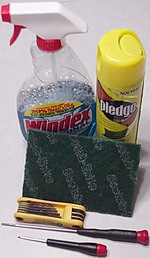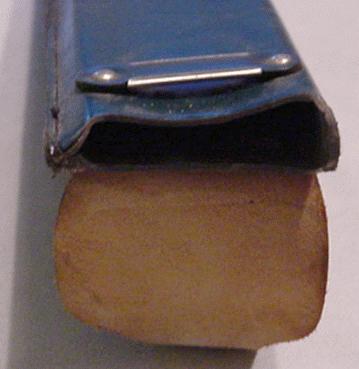Cleaning and Caring for Slide Rules This Section Updated Regularly
This Section Updated RegularlyClick REFRESH on your browser if pages seem unchanged |  |
Sphere Research Corporation 3394 Sunnyside Rd. West Kelowna, BC, Canada V1Z 2V4 Phone: +1 (250) 769-1834 A great source for test equipment, repairs, calibrations, useful metrology information, and of course, SLIDE RULES! Just |
| Welcome to the Slide Rule Universe! |
| I'm in a HURRY! Show me all the: |

(more to come!) 
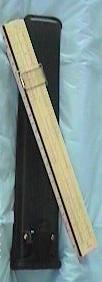 WOOD Body Rules WOOD Body RulesWood body rules should be stored in a case, out of any severe temperature or humidity changes. Other than the 4058, the K+E wood bodies are made of Mahogany, which is relatively stable, but can be distorted by prolonged exposure to water or sunlight and heat, especially if applied to only an exposed portion of the rule. The scales are made of celluloid (not Ivory as many people think), and will delaminate from the wood if the rule is soaked or exposed to large temperature changes. Cleaning the engraved scales is best accomplished with a fine scotch brite pad or steel wool (K+E says steel wool, but I prefer the softer pad). Gentle rubbing along the body and slide will remove any surface grime and discoloring, without touching the engraved and filled scales. Many people are reluctant to do this, but keep in mind, this is what K+E recommends, and it works very well if you are careful and patient. Avoid spot rubbing by this method, as it will cause patches of different body color. Once you start this method, you should gently rub down the entire side of the rule to maintain a consistent appearance and reflection. Cleaning the cursor is much simpler if it can be removed easily, and wiped with a soft cloth or paper towel, dampened with warm water. If it is a duplex rule like the 4081, you may not wish to remove the cursor, and you can slide a piece of white paper under the glass, and gently press on the glass, while moving the cursor along it. This will generally rub any accumulated dirt off of the cursor, and onto the paper. You can help this with a drop of water or Windex on the paper in stubborn cases. K+E used to sell paper triangles for just this cleaning task. A word of caution: Windex will sometimes dissolve the ink used to mark the cursor line, and create more problems, so be careful when cleaning the surface of the cursor with the engraved and filled line. Also, some older K+E cursors (with a matte, off-white appearance) have a very poor material used as the slider, and it can break or crumble when handled or dampened, ruining the cursor assembly. Spare parts to fix this problem are pretty much non-existent, so be very careful. You can also use a rag dampened with Windex, and this will help to clean ink stained and dirty surfaces, as well as the edges of the slide and body. There should be no dirt in the sliding portion of the rule, and a rag with a small bit of Windex will help to remove any accumulated dirt and abraded material. I do not recommend waxing the rule face (as it collects and traps dirt, especially under the cursor), BUT you may wish to lightly rub the faces and edges with a very small amount of Pledge to give a shiny appearance if the rule is mainly for display. Wax, or preferably Pledge, will often bring out the wood highlights in a very attractive way on edges of rules such as the 4053 and some 4081 rules. Anything in the sliding area of a wood rule generally increases friction and binding, but the nature of Pledge is to make the surface very slippery, and it works well as a lubricant. The best possible technique is to have this area as clean and free of rough edges and burrs as you can make it. If this area is rough and sticks, and it has already been well cleaned and the gap is correctly set, a very light rub with Pledge may improve the action. The case should be cleaned with a damp cloth and some Windex for stains and marks, and once dry, rubbed with a good leather polish or Pledge, and shined. Leather will dry and crack if not moisturized by some method, so don't ignore the case. Often, a previous owner will mark up the inside flap with a name, address, school, etc., making the case quite unattractive. it is possible to remove SOME inside flap markings by gentle abrasion with sandpaper (I use a slow belt sander), to remove the top layer of the leather, but this is not for the faint of heart. Never attempt to remove the markings with any solvent, or you will almost certainly stain and ruin the case.
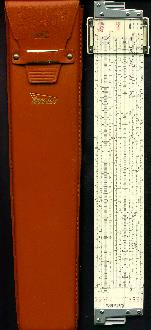 PLASTIC Body Rules PLASTIC Body RulesK+E made rules of Xylonite (a slightly off-white more matte material), such as the 4097 series, and of Ivorite (a whiter, smoother material), such as the 4181 and Deci-lon series. Xylonite rules (4097 and similar) are quite brittle, and often show stress cracks and retain dirt, Ivorite rules are very durable, have much smoother sliding action, and clean well. These rules should be stored in a case to protect the cursor, and not exposed to any severe temperatures or extreme sunlight. Xylonite rules can be distorted, or discolored by prolonged exposure to water or sunlight and heat, especially if applied to only an exposed portion of the rule. Unlike wood rules, plastic body rules cannot delaminate, and are made of a single solid material. Except for the painted scales on the K-12 rule, the 68-1292, cleaning the engraved scales on a plastic body rule is best accomplished with a fine scotch brite pad or steel wool (K+E says steel wool, but I prefer the pad). Gentle rubbing along the body and slide will remove any surface grime and discoloring, without touching the engraved and filled scales. Many people are reluctant to do this, but keep in mind, this is what K+E recommends, and it works very well if you are careful and patient.
 Watch this rule return from the dead below. 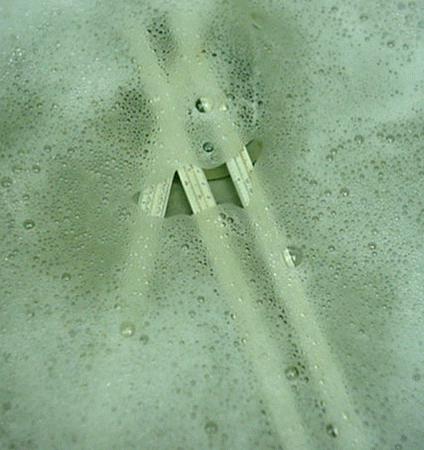 Washing in warm water and Palmolive dish detergent can help de-grime some plastic body rules, and cleans out many crevices. 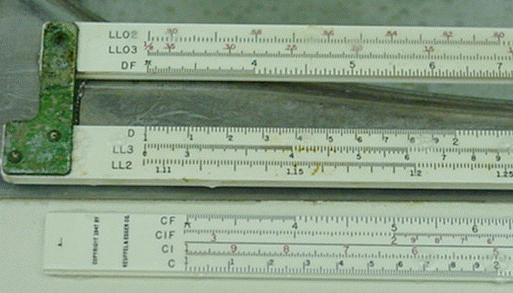 Notice how the surfaces are restored with just some gentle rubbing and a scotchbrite pad. 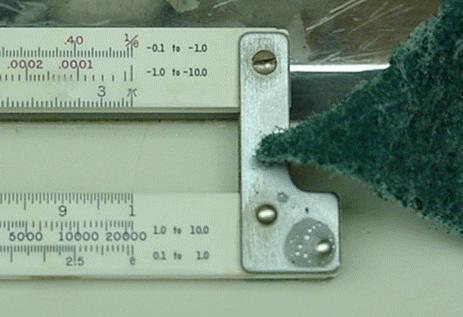 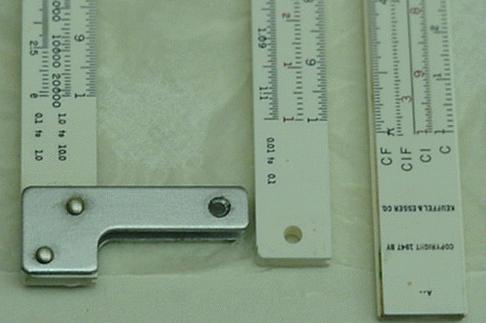 How the parts look when you are finished. Yes, it's the same rule as shown at the top! A word of caution: Windex will sometimes dissolve the ink used to mark the cursor line, and create more problems, so be careful when cleaning the surface of the cursor with the engraved and filled line. Some plastic body rules, especially the 4181 and Doric rules, used a scale fill material that dissolves in Windex, resulting in a smeared appearance when the rule is washed with Windex. You can also generally use a rag dampened with Windex, and this will help to clean ink stained and dirty surfaces, as well as the edges of the slide and body. There should be no dirt in the sliding portion of the rule, and a rag with a bit of Windex will help to remove any accumulated dirt and abraded material. I do not recommend waxing (heavy wax) a plastic rule for any reason. Anything in the sliding area of a plastic rule generally increases friction and binding, and the best possible technique is to have this area as clean and smooth as you can. If the rule sticks, and it has already been well cleaned and the gap is correctly set, a very light wipe with dry powdered teflon or a very small amount of Pledge will improve action, and will not mark the rule. The case should be cleaned with a damp cloth and some Windex for stains and marks, and once dry, rubbed with a good leather polish or hard wax, and shined. Leather will dry and crack if not moisturized by some method, so don't ignore the case. Often, a previous owner will mark up the inside flap with a name, address, school, etc., making the case quite unattractive. it is possible to remove SOME flap markings by gentle abrasion with sandpaper, to remove the top layer of the leather, but this is not for the faint of heart. Never attempt to remove the markings with any solvent, or you will almost certainly stain and ruin the case.
 Hemmi bamboo core rules have a very similar celluloid laminate scale design to K+E wood body rules, and the same techniques work well on these rules. A gentle abrasive pad like scotchbrite will restore the face of most rules, and remove many marks. The entire surface or side usually has to be done at one time, to keep the appearance uniform. Bamboo is naturally self-lubricating, so nothing is really required to keep motion uniform and smooth, BUT the surfaces can become rough after long storage (ends of fibers become exposed), and rubbing the sliding surfaces with that same scotchbrite pad will restore the smooth surface, and improve the action. If the bamboo is severely dried out, a gentle rub with a cloth that has a bit of Pledge will usually restore the action. You may need to adjust the body frame if action is too loose or tight, this is done by slightly loosening the two top body screws, and bringing the scales into alignment, and then adjusting width to give the desired action.  Fixing Cursors Fixing CursorsA common problem with rules is that the cursor may get broken, or the line disappear. These problems can both be fixed with some care. If the cursor has glass faces, the only workable solution for a broken lens is a new one, and spare parts do exist for many rules (we have them HERE). If a spare parts can't be found, often a poor rule can be scrapped to create the required parts. K+E and Dietzgen glass is particularly hard to find, and getting parts from a salvage rule is often the best way to restore another usable rule. Cursor sides also deteriorate, and again, salvage parts or new parts will be needed. Dave Crate has new machined parts for the the K+E 4081 cursor sides. Remember that once the parts are replaced, the cursor has to be aligned for straightness to the index edge to give usuable performance. You can often get a poor rule off of e-bay cheaply to strip for parts, and restore your broken rule. We often have to do this to get parts/ IF THE CURSOR LINE DISAPPEARS, take it apart, and clean it well. if it is a glass cursor, you can refill the line from the rear with a fine tipped permanent marker like a Staedtler-Mars Lumocolor, and then rub off any excess outside the line or wipe it clear with a soft cloth and some Windex. This can restore the cursor lens to new condition. If the lens is plastic, this technique is dangerous, as it may stain the clear lens. In this case, you may be able to use a water soluable marker to fill the line, and rub off any excess. NEED TO CLEAN UNDER A CURSOR? This is actualy very easy, and you don't have to take anything apart. Take a thin stip of 20 pound printer or copier paper, and slide it under the cursor. Gently press the cursor down againt the paper, and rub the cursor away from the paper along the rule. The dirt will adhere to the paper, and leave the lens clean. if the residue is thick, or waxy, a drop of Windex on the paper will help clean the back of the lens. This takes a bit of practice, but is easy to do once you have tried it a few times. Some people prefer traingles of paper, but it's up to you. Walt's Demented Case Trick From the Dark Side: Often the green fiber cases from K+E get "collapsed", and make inserting and removing the rule almost impossible, plus they usually crack when flexed, so there is no easy way to restore the shape, or even to use the case. 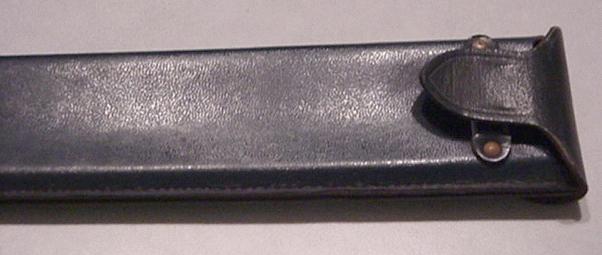 Typical useless and irritating K+E collapsed cases.
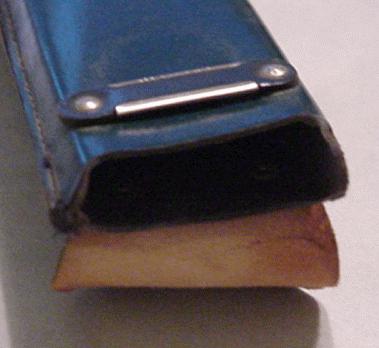 Here's how the same cases looked after 'steam treatment' and a gentle squeeze. 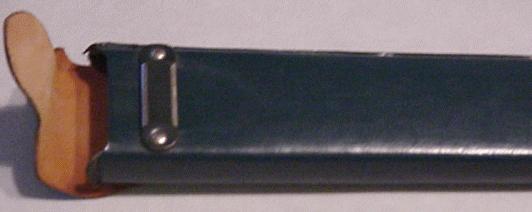 I fixed about a half dozen cases this way in just 10 minutes, and the results were amazing. Worth a try if you have one of these squashed cases.  NEVER FORGET, all rule makers advise you always keep your rule clean and in good repair. If the rule gets dirty, it will mark up the back of the cursor, and will be hard to read and operate.   You are visitor number You are visitor number
Site Design & contents copyright 1997, 1998, 1999, 2000, 2001, 2002, 2003, 2007, 2008, 2013, 2017 by Walter Shawlee 2 & the ad hoc Godzilla Graphics Group. |
